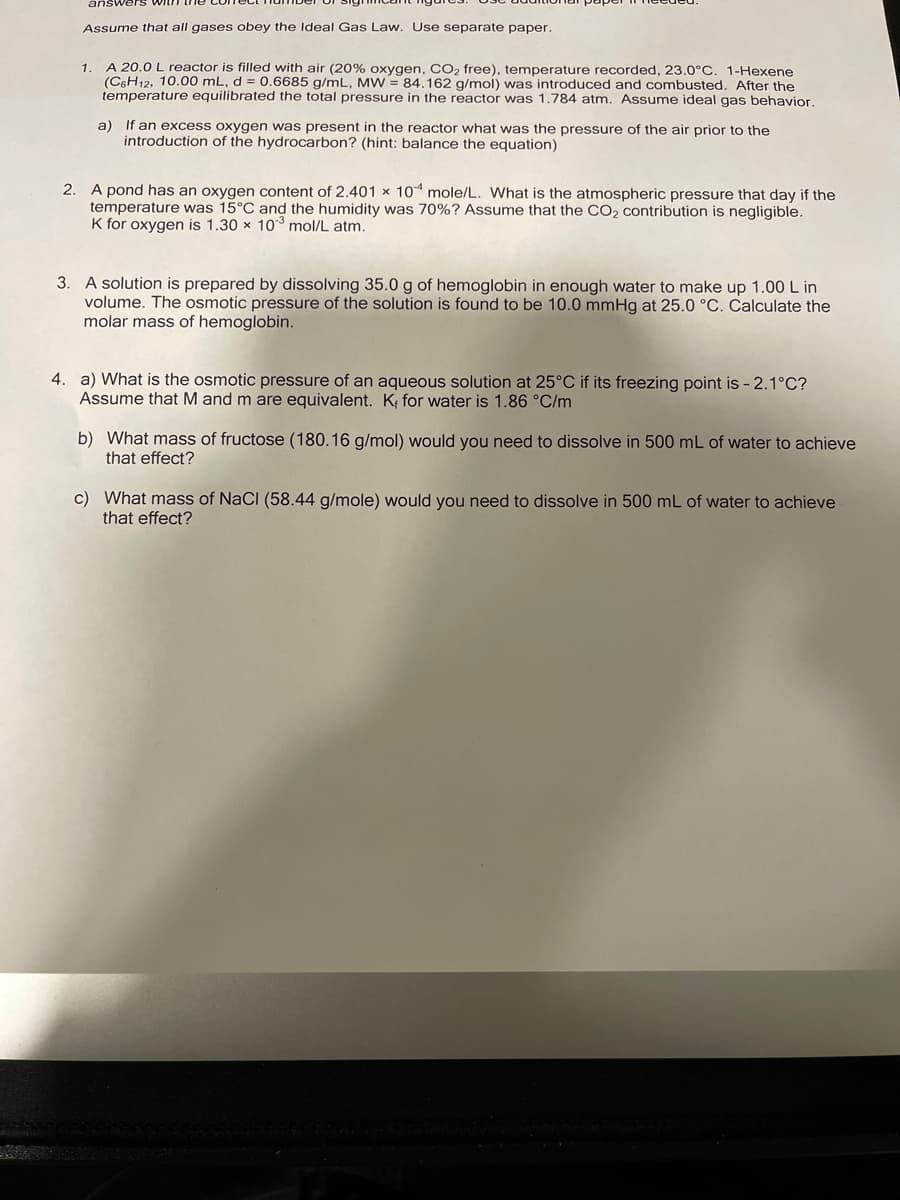4. a) What is the osmotic pressure of an aqueous solution at 25°C if its freezing point is -2.1°C? Assume that M and m are equivalent. K, for water is 1.86 °C/m b) What mass of fructose (180.16 g/mol) would you need to dissolve in 500 mL of water to achieve that effect? c) What mass of NaCl (58.44 g/mole) would you need to dissolve in 500 mL of water to achieve that effect?
4. a) What is the osmotic pressure of an aqueous solution at 25°C if its freezing point is -2.1°C? Assume that M and m are equivalent. K, for water is 1.86 °C/m b) What mass of fructose (180.16 g/mol) would you need to dissolve in 500 mL of water to achieve that effect? c) What mass of NaCl (58.44 g/mole) would you need to dissolve in 500 mL of water to achieve that effect?
General Chemistry - Standalone book (MindTap Course List)
11th Edition
ISBN:9781305580343
Author:Steven D. Gammon, Ebbing, Darrell Ebbing, Steven D., Darrell; Gammon, Darrell Ebbing; Steven D. Gammon, Darrell D.; Gammon, Ebbing; Steven D. Gammon; Darrell
Publisher:Steven D. Gammon, Ebbing, Darrell Ebbing, Steven D., Darrell; Gammon, Darrell Ebbing; Steven D. Gammon, Darrell D.; Gammon, Ebbing; Steven D. Gammon; Darrell
Chapter5: The Gaseous State
Section: Chapter Questions
Problem 5.127QP: A 1.000-g sample of an unknown gas at 0C gives the following data: P(atm) V (L) 0.2500 3.1908 0.5000...
Related questions
Question
4 please

Transcribed Image Text:answers withh
Assume that all gases obey the Ideal Gas Law. Use separate paper.
1
A 20.0 L reactor is filled with air (20% oxygen, CO2 free), temperature recorded, 23.0°C. 1-Hexene
(C6H12, 10.00 mL, d = 0.6685 g/mL, MW = 84.162 g/mol) was introduced and combusted. After the
temperature equilibrated the total pressure in the reactor was 1.784 atm. Assume ideal gas behavior.
a) If an excess oxygen was present in the reactor what was the pressure of the air prior to the
introduction of the hydrocarbon? (hint: balance the equation)
2. A pond has an oxygen content of 2.401 x 10 mole/L. What is the atmospheric pressure that day if the
temperature was 15°C and the humidity was 70%? Assume that the CO2 contribution is negligible.
K for oxygen is 1.30 x 10*3 mol/L atm.
3. A solution is prepared by dissolving 35.0 g of hemoglobin in enough water to make up 1.00 L in
volume. The osmotic pressure of the solution is found to be 10.0 mmHg at 25.0 °C. Calculate the
molar mass of hemoglobin.
4. a) What is the osmotic pressure of an aqueous solution at 25°C if its freezing point is - 2.1°C?
Assume that M and m are equivalent. K; for water is 1.86 °C/m
b) What mass of fructose (180.16 g/mol) would you need to dissolve in 500 mL of water to achieve
that effect?
c) What mass of NaCl (58.44 g/mole) would you need to dissolve in 500 mL of water to achieve
that effect?
Expert Solution
This question has been solved!
Explore an expertly crafted, step-by-step solution for a thorough understanding of key concepts.
Step by step
Solved in 2 steps

Knowledge Booster
Learn more about
Need a deep-dive on the concept behind this application? Look no further. Learn more about this topic, chemistry and related others by exploring similar questions and additional content below.Recommended textbooks for you

General Chemistry - Standalone book (MindTap Cour…
Chemistry
ISBN:
9781305580343
Author:
Steven D. Gammon, Ebbing, Darrell Ebbing, Steven D., Darrell; Gammon, Darrell Ebbing; Steven D. Gammon, Darrell D.; Gammon, Ebbing; Steven D. Gammon; Darrell
Publisher:
Cengage Learning

Chemistry for Engineering Students
Chemistry
ISBN:
9781337398909
Author:
Lawrence S. Brown, Tom Holme
Publisher:
Cengage Learning

Chemistry: Principles and Reactions
Chemistry
ISBN:
9781305079373
Author:
William L. Masterton, Cecile N. Hurley
Publisher:
Cengage Learning

General Chemistry - Standalone book (MindTap Cour…
Chemistry
ISBN:
9781305580343
Author:
Steven D. Gammon, Ebbing, Darrell Ebbing, Steven D., Darrell; Gammon, Darrell Ebbing; Steven D. Gammon, Darrell D.; Gammon, Ebbing; Steven D. Gammon; Darrell
Publisher:
Cengage Learning

Chemistry for Engineering Students
Chemistry
ISBN:
9781337398909
Author:
Lawrence S. Brown, Tom Holme
Publisher:
Cengage Learning

Chemistry: Principles and Reactions
Chemistry
ISBN:
9781305079373
Author:
William L. Masterton, Cecile N. Hurley
Publisher:
Cengage Learning

Physical Chemistry
Chemistry
ISBN:
9781133958437
Author:
Ball, David W. (david Warren), BAER, Tomas
Publisher:
Wadsworth Cengage Learning,

Chemistry: An Atoms First Approach
Chemistry
ISBN:
9781305079243
Author:
Steven S. Zumdahl, Susan A. Zumdahl
Publisher:
Cengage Learning

Chemistry
Chemistry
ISBN:
9781305957404
Author:
Steven S. Zumdahl, Susan A. Zumdahl, Donald J. DeCoste
Publisher:
Cengage Learning